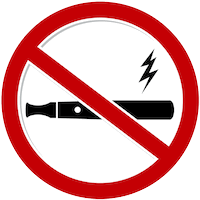Once upon a time, smokers could calm their nicotine cravings on a plane by using electronic cigarettes, or “e-cigarettes.” They originally became a smoker’s best friend in public places where smoking is normally not permissible until more and more local and state governments began defining them as “tobacco products” and subjecting them to the same bans while awaiting the final ruling on how the FDA will regulate them at the federal level. Whether or not vapers were permitted to use e-cigs on planes was previously up to the airlines; however, that is no longer the case as of April 4, 2016.
E-Cig Ban: No More Vaping Inflight

That’s right, the United States Department of Transportation has officially banned the use of vaporizers during flights across the US. The support for this law, which Congress just passed in March, came from the consequences of several unfortunate incidents that occurred in the past few years in America’s airports. For example, one e-cigarette reportedly started a fire from inside a passenger’s luggage at Logan International Airport in 2014.
Additional stories have popped into the news about e-cigarettes exploding in Kentucky and Florida, and in one scenario, the vaporizer exploded inside a man’s pocket, giving him multiple second-degree burns. Adding to these cases, arguments also appeared before Congress claiming that the aerosols in e-cigarettes aren’t safe for passengers in a confined space such as an airplane. Gravely concerned about the consequences of e-cigarette explosions happening on an aircraft in flight and the possible health hazards of increased exposure to possibly toxic aerosol fumes in cramped airplane cabins, Congress passed the bill without much opposition.
Nevertheless, Republican congressman Duncan Hunter brought his vaporizer to the committee to initiate a live demonstration of how vaping devices work in order to contest the argument that the aerosol from e-liquid vaporizers contains harmful chemicals similar to secondhand tobacco smoke. Hunter’s Chief of Staff also brought up the point that anything with a battery or “anything else with a potential to ignite under extreme conditions” is also technically a fire hazard as well, so why should lawmakers single out vaporizers alone–especially when the majority of incidents of exploding e-cigs occurred due to user error rather than the product itself?
In the end, Congress decided to mildly compromise by stating that this new ban shouldn’t apply to inhalers or other aerosol products deemed necessary for medical reasons. Still, it’s important to ask the question: Is secondhand vapor from an e-cigarette really as harmful as regular cigarette smoke?
E-Cig Vapor Still Viewed as Harmful, Despite Research

With all the opposing views and conflicting studies on e-cigs, it’s questionable whether this decision was based on accurate information. The truth is that multiple studies have proven the secondhand vapor from e-cigarettes is no more harmful than breathing the air outside.
Such sources of this data come from the Public Health England’s evidence-based review on e-cigs, as well as studies published in the journal of Regulatory Toxicology and Pharmacology and other studies conducted by the British American Tobacco Association and MatTek corporation. Specifically, New York’s Roswell Park Cancer Institute found in their study that the only thing present in secondhand e-cigarette vapors is small amounts of nicotine that aren’t injurious to anyone’s health.
On the other hand, the concentration of nicotine is 10 times higher in smoke from real cigarettes, which also contains harmful chemicals like carbon monoxide and other toxic organic compounds proven to cause cancer, such as formaldehyde, benzene, arsenic and hydrogen cyanide. None of those toxic additives in cigarette tobacco are present in e-cigarettes.
Related: Studies Continue to Prove E-Cig Vapor is Less Harmful than Tobacco Smoke
Despite the evidence mentioned above, vaping critics still claim more evidence is needed to determine the long-term effects of e-cig vapor both for users and bystanders. So in the meantime, vapers will have to refrain from using their vaping devices during commercial flights; however, they are still permitted to bring them in their carryon luggage only, as e-cigs have been banned from checked luggage since 2015. Therefore, when the time comes to plan your next trip, be sure to plan ahead and follow the rules for vaping during air travel.






